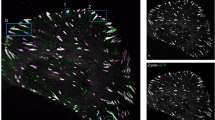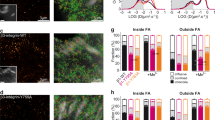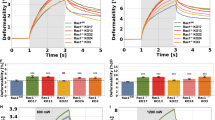Abstract
Focal adhesions are large multi-protein assemblies that form at the basal surface of cells on planar dishes, and that mediate cell signalling, force transduction and adhesion to the substratum. Although much is known about focal adhesion components in two-dimensional (2D) systems, their role in migrating cells in a more physiological three-dimensional (3D) matrix is largely unknown. Live-cell microscopy shows that for cells fully embedded in a 3D matrix, focal adhesion proteins, including vinculin, paxillin, talin, α-actinin, zyxin, VASP, FAK and p130Cas, do not form aggregates but are diffusely distributed throughout the cytoplasm. Despite the absence of detectable focal adhesions, focal adhesion proteins still modulate cell motility, but in a manner distinct from cells on planar substrates. Rather, focal adhesion proteins in matrix-embedded cells regulate cell speed and persistence by affecting protrusion activity and matrix deformation, two processes that have no direct role in controlling 2D cell speed. This study shows that membrane protrusions constitute a critical motility/matrix-traction module that drives cell motility in a 3D matrix.
This is a preview of subscription content, access via your institution
Access options
Subscribe to this journal
Receive 12 print issues and online access
$209.00 per year
only $17.42 per issue
Buy this article
- Purchase on Springer Link
- Instant access to full article PDF
Prices may be subject to local taxes which are calculated during checkout





Similar content being viewed by others
References
Sastry, S. K. & Burridge, K. Focal adhesions: a nexus for intracellular signaling and cytoskeletal dynamics. Exp. Cell Res. 261, 25–36 (2000).
Riveline, D. et al. Focal contacts as mechanosensors: externally applied local mechanical force induces growth of focal contacts by an mDia1-dependent and ROCK-independent mechanism. J. Cell Biol. 153, 1175–1186 (2001).
Miyamoto, S. et al. Integrin function — molecular hierarchies of cytoskeletal and signaling molecules J. Cell Biol. 131, 791–805 (1995).
Gilmore, A. P. & Burridge, K. Regulation of vinculin binding to talin and actin by phosphatidyl-inositol-4-5-bisphosphate. Nature 381, 531–535 (1996).
Cukierman, E., Pankov, R., Stevens, D. R. & Yamada, K. M. Taking cell-matrix adhesions to the third dimension. Science 294, 1708–1712 (2001).
Cukierman, E., Pankov, R. & Yamada, K. M. Cell interactions with three-dimensional matrices. Curr. Opin. Cell Biol. 14, 633–639 (2002).
Mao, Y. & Schwarzbauer, J. E. Accessibility to the fibronectin synergy site in a 3D matrix regulates engagement of α5β1 versus αvβ3 integrin receptors. Cell Commun. Adhes. 13, 267–277 (2006).
Mao, Y. & Schwarzbauer, J. E. Fibronectin fibrillogenesis, a cell-mediated matrix assembly process. Matrix Biol. 24, 389–399 (2005).
Friedl, P., Entschladen, F., Conrad, C., Niggemann, B. & Zanker, K. S. CD4+ T lymphocytes migrating in three-dimensional collagen lattices lack focal adhesions and utilize β1 integrin-independent strategies for polarization, interaction with collagen fibers and locomotion. Eur. J. Immunol. 28, 2331–2343 (1998).
Petroll, W. M., Ma, L. & Jester, J. V. Direct correlation of collagen matrix deformation with focal adhesion dynamics in living corneal fibroblasts. J. Cell Sci. 116, 1481–1491 (2003).
Wehrle-Haller, B. & Imhof, B. The inner lives of focal adhesions. Trends Cell Biol. 12, 382–389 (2002).
Pelham, R. J., Jr. & Wang, Y. Cell locomotion and focal adhesions are regulated by substrate flexibility. Proc. Natl Acad. Sci. USA 94, 13661–13665 (1997).
Shemesh, T., Geiger, B., Bershadsky, A. D. & Kozlov, M. M. Focal adhesions as mechanosensors: a physical mechanism. Proc. Natl Acad. Sci. USA 102, 12383–12388 (2005).
Hanada, M. et al. Focal adhesion kinase is activated in invading fibrosarcoma cells and regulates metastasis. Clin. Exp. Metastasis 22, 485–494 (2005).
Salgia, R. et al. Expression of the focal adhesion protein paxillin in lung cancer and its relation to cell motility. Oncogene 18, 67–77 (1999).
Yu, Y. P. & Luo, J. H. Myopodin-mediated suppression of prostate cancer cell migration involves interaction with zyxin. Cancer Res. 66, 7414–7419 (2006).
Lo, C. M., Wang, H. B., Dembo, M. & Wang, Y. L. Cell movement is guided by the rigidity of the substrate. Biophys. J. 79, 144–152 (2000).
Wolf, K. et al. Compensation mechanism in tumor cell migration: mesenchymal-amoeboid transition after blocking of pericellular proteolysis. J. Cell Biol. 160, 267–277 (2003).
Wolf, K. et al. Multi-step pericellular proteolysis controls the transition from individual to collective cancer cell invasion. Nature Cell Biol. 9, 893–904 (2007).
Zhou, X. et al. Fibronectin fibrillogenesis regulates three-dimensional neovessel formation. Genes Dev. 22, 1231–1243 (2008).
Sabeh, F., Shimizu-Hirota, R. & Weiss, S. J. Protease-dependent versus -independent cancer cell invasion programs: three-dimensional amoeboid movement revisited. J. Cell Biol. 185, 11–19 (2009).
Ren, X. D. et al. Focal adhesion kinase suppresses Rho activity to promote focal adhesion turnover. J. Cell Sci. 113, 3673–3678 (2000).
Panorchan, P., Lee, J. S., Kole, T. P., Tseng, Y. & Wirtz, D. Microrheology and ROCK signaling of human endothelial cells embedded in a 3D matrix. Biophys. J. 91, 3499–3507 (2006).
Lee, J. S. et al. Ballistic intracellular nanorheology reveals ROCK-hard cytoplasmic stiffening response to fluid flow. J. Cell Sci. 119, 1760–1768 (2006).
Bloom, R. J., George, J. P., Celedon, A., Sun, S. X. & Wirtz, D. Mapping local matrix remodeling induced by a migrating tumor cell using three-dimensional multiple-particle tracking. Biophys. J. 95, 4077–4088 (2008).
Webb, D. J. et al. FAK-Src signalling through paxillin, ERK and MLCK regulates adhesion disassembly. Nature Cell Biol. 6, 154–161 (2004).
Ridley, A. J. et al. Cell migration: integrating signals from front to back. Science 302, 1704–1709 (2003).
Kole, T. P., Tseng, Y., Jiang, I., Katz, J. L. & Wirtz, D. Intracellular mechanics of migrating fibroblasts. Mol. Biol. Cell 16, 328–338 (2005).
Munevar, S., Wang, Y. L. & Dembo, M. Distinct roles of frontal and rear cell-substrate adhesions in fibroblast migration. Mol. Biol. Cell 12, 3947–3954 (2001).
Geiger, B., Spatz, J. P. & Bershadsky, A. D. Environmental sensing through focal adhesions. Nature Rev. Mol. Cell Biol. 10, 21–33 (2009).
Tilghman, R. W. & Parsons, J. T. Focal adhesion kinase as a regulator of cell tension in the progression of cancer. Semin. Cancer Biol. 18, 45–52 (2008).
Ngu, H. et al. Effect of focal adhesion proteins on endothelial cell adhesion, motility and orientation response to cyclic strain. Ann. Biomed. Eng. 38, 208–222 (2010).
Acknowledgements
The authors acknowledge support from NIH (CA143868, GM084204, GM080673, and CA85839). S.I.F. was supported by ARCS and NSF-GRFP. We thank Michael McCaffery and Ned Perkins for help with confocal microscopy, members of the Wirtz and Longmore groups for helpful discussions, and John Isaacs of JHMI and his group for generously providing E006AA prostate cancer cells.
Author information
Authors and Affiliations
Contributions
Y.F. generated knockdowns; R.K. helped with data analysis and figures; D.K. supplied PA substrates of varying stiffness; A.C. developed Matlab code to track beads in traction experiments; S.F. performed all experiments and analysis and co-wrote the manuscript; G.L. and D.W. co-supervised the project and co-wrote the manuscript.
Corresponding authors
Ethics declarations
Competing interests
The authors declare no competing financial interests.
Supplementary information
Supplementary Information
Supplementary Information (PDF 767 kb)
Rights and permissions
About this article
Cite this article
Fraley, S., Feng, Y., Krishnamurthy, R. et al. A distinctive role for focal adhesion proteins in three-dimensional cell motility. Nat Cell Biol 12, 598–604 (2010). https://doi.org/10.1038/ncb2062
Received:
Accepted:
Published:
Issue Date:
DOI: https://doi.org/10.1038/ncb2062
This article is cited by
-
Synthetic living materials in cancer biology
Nature Reviews Bioengineering (2023)
-
Curved adhesions mediate cell attachment to soft matrix fibres in three dimensions
Nature Cell Biology (2023)
-
3D collagen migration patterns reveal a SMAD3-dependent and TGF-β1-independent mechanism of recruitment for tumour-associated fibroblasts in lung adenocarcinoma
British Journal of Cancer (2023)
-
Hypoxic regulation of ADAMTS-2 and -3 (a disintegrin and matrix metalloproteinase with thrombospondin motifs 2 and 3) procollagen N proteinases by HIF-1α in endothelial cells
Molecular and Cellular Biochemistry (2023)
-
The Influence of Nucleus Mechanics in Modelling Adhesion-independent Cell Migration in Structured and Confined Environments
Bulletin of Mathematical Biology (2023)



